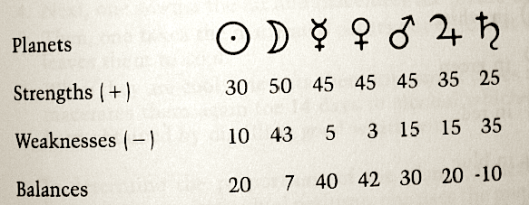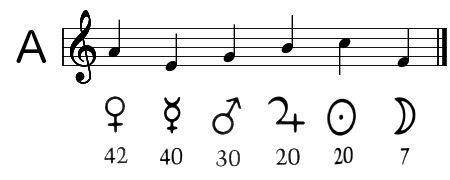I recently began reading some of the work of Paschal Beverly Randolph (1825-1875), and was intrigued to discover a formula for composing magical melodies in his notorious Magia Sexualis. Unfortunately the instructions, on pp.69-74 of the 1931 French first edition and pp. 41-44 of the 1987 English translation, are almost incoherent: obviously some sort of editorial error or misreading of Randolph’s manuscript occurred prior to publication, and since neither translator was a musician the instructions have remained somewhat opaque. I am not sure if these errors are corrected in Donald Traxler’s 2012 translation, but I am posting my own synopsis of his method for those who are curious.
Randolph’s discussion of ‘magical melody’ occurs in chapter IX, dedicated to astrology and its relation to colour, perfume and sound as ritual enhancements. His magical melodies in fact relate to a long tradition of ‘speculative music‘, which seeks to acoustically demonstrate the otherwise inaudible harmonies of the planetary spheres. Vital for comprehending Randolph’s instructions is his table of planetary correspondences:

The first stage is to cast the natal horoscope of the operator(s) and to evaluate the strengths and weaknesses of each planet in order to arrive at a series of ‘balances’ indicating the relative power of each planet in the figure. Here is Randolph’s example:

Saturn, having a negative balance, is discounted from any colour, perfume or melody that will be contrived from the data. With regard to the composition of a ‘magical melody’, Randolph suggests reducing the balances to a series of values between 1 and 5, for example:

However – having deciphered Randolph’s subsequent instructions, I’m not sure if this stage is necessary at all! In the first instance, one must do is arrange the planets in a scale of force, arranged from the most to least potent (5 5 4 3 1 to use what I will call his ‘value notation’):

Next, Randolph tells us to ‘inscribe the forces according to the number symolising the planet’. This basically means to sort the scale based on the numbers corresponding to each planet that is present. Saturn corresponds to number 3, but is omitted, so the scale will start with B (associated with Jupiter and the number 4):

Finally, we arrange the notes in Randolph’s favoured planetary order, as shown in his table of correspondences:

You’ll notice that I have labelled these phrases A, B and D. This is because Randolph refers to ‘diagrams A B & D’, which are mislabelled in the text, but are graphic representations of the phrases as shown above. However, in Randolph’s original text their meaning is rather confounded by his adaptation of the ‘value notation’ to indicate the force of each planet, rather than the pitch itself (e.g. in phrase A, both Venus and Mercury posses a value of 5 – although the Venus tone precedes the Mercury tone since its total ‘balance’ is greater than that of Mercury):

The actual content of the piece itself is created by combining these phrases and their retrogrades:

This provided the tonal contour for the piece. The note durations are also assigned based on the relative ‘force’ that each planet possesses: Randolph suggests a whole note for the most powerful planets/tones, a half note for the second most powerful and so on. The more powerful planets/tones are also emphasised by repetition. In the example that Randolph provides, it seems that the most powerful tones are usually represented by a half-note, although this is confusingly often articulated as a quarter note and quarter rest, as in the opening bars of Randolph’s composition:

Note that the last two tones of D-retrograde, which would be moon and sun, are omitted from Randolph’s example. The downward arrows represent moments when the tones should be reinforced by an octave in order to ‘accentuate the most important influences’ (- as notated in the first two bars). You’ll notice that the meter is very eccentric, but I have had a go at my own interpretation of his ‘magical melody’. The tempo is quite free: it’s hardly ‘sexy’… but it does feel quite ‘Randolph’.
To hear the melody more clearly, here’s another example of the same material, but without repeated notes, and a rigid adherence to the rhythmic values associated with each tone. You will hear the three phrases, A, B and D played at the start, and then the sequence A, B, B-retrograde, A-retrograde, D, D-retrograde is played twice:

This Is fantastic. One question about the table of relative strengths and weaknesses: is he going by the dignities of the planets?
Since you’ve provided his table of strengths and weaknesses, would you also happen to have a copy of his horoscope? His birth date is well known although I haven’t seen his birth time, which would be key of course for house system but also for the table of strengths and weaknesses (Asc. /houses change signs every 2 hours).
Thanks a lot, great site